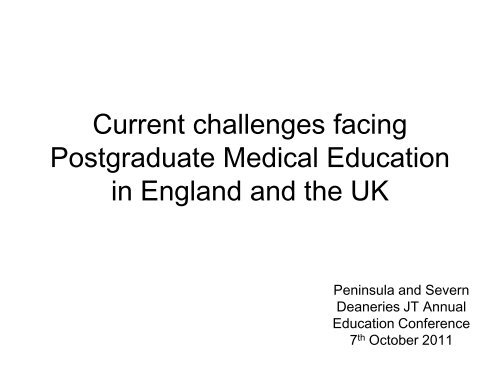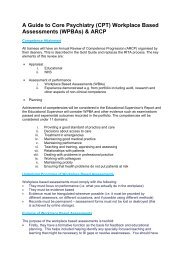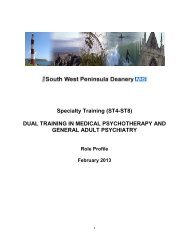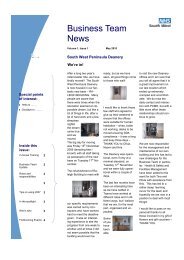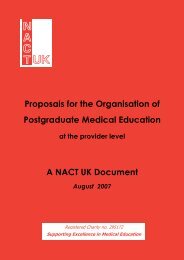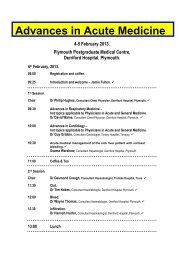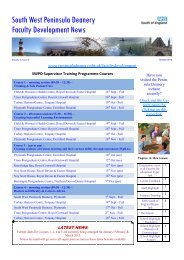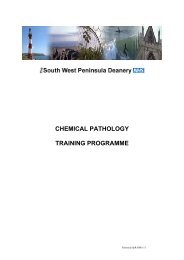Current challenges facing Postgraduate Medical Education in ...
Current challenges facing Postgraduate Medical Education in ...
Current challenges facing Postgraduate Medical Education in ...
You also want an ePaper? Increase the reach of your titles
YUMPU automatically turns print PDFs into web optimized ePapers that Google loves.
<strong>Current</strong> <strong>challenges</strong> <strong>fac<strong>in</strong>g</strong><br />
<strong>Postgraduate</strong> <strong>Medical</strong> <strong>Education</strong><br />
<strong>in</strong> England and the UK<br />
Pen<strong>in</strong>sula and Severn<br />
Deaneries JT Annual<br />
<strong>Education</strong> Conference<br />
7 th October 2011
Cover<strong>in</strong>g:<br />
• Strategic considerations<br />
• “operational issues”<br />
• Research and development
1. Strategic considerations
1<br />
Key Knowns<br />
• Arrangements for health services and pgme are<br />
<strong>in</strong>creas<strong>in</strong>gly <strong>in</strong>fluenced by country specific<br />
factors (England and DAs)<br />
• Fiscal constra<strong>in</strong>ts will worsen not ease<br />
• SHAs will rema<strong>in</strong> until April 2013 but as 4<br />
clusters<br />
: London<br />
: South and South West<br />
: Midlands and East<br />
: North
2<br />
• PG Deaneries (<strong>in</strong>clud<strong>in</strong>g PG Deans!) and their<br />
staff are to be secured; l<strong>in</strong>ked to LETBs<br />
• As are SHA workforce and educational<br />
commission<strong>in</strong>g staff<br />
• HEE will be established (SpHA) and operational<br />
asap, and will oversee the creation of local NHS<br />
<strong>Education</strong> and Tra<strong>in</strong><strong>in</strong>g Board (LETB) via a<br />
“rigorous authorisation process”
3<br />
• Employers will have greater accountability and<br />
responsibility to plan and develop their<br />
workforce (with<strong>in</strong> LETB framework)<br />
• A greater focus on multi-professional workforce<br />
plann<strong>in</strong>g and education [sic]<br />
note: do they mean IPE?<br />
• Development of a national education and<br />
tra<strong>in</strong><strong>in</strong>g outcomes framework (EOF)
4<br />
• Phased transition to provider led LETBs<br />
• <strong>Education</strong> and tra<strong>in</strong><strong>in</strong>g fund<strong>in</strong>g “to be protected”<br />
• Fund<strong>in</strong>g allocation with <strong>in</strong>creased fairness and<br />
transparency (DN: does this mean “improved<br />
equity”?)<br />
• Specific arrangements for small professions and<br />
specialties via HEE
5<br />
Timel<strong>in</strong>e for transition/change<br />
Oct 11<br />
Dec 11<br />
Draft framework agreement for HEE NHS CB established <strong>in</strong><br />
shadow form as SpHA<br />
HEE top team appo<strong>in</strong>ted<br />
April 12<br />
(earliest)<br />
Oct 12 (latest)<br />
By Oct 12<br />
HEE established as SpHA <strong>in</strong> shadow form (not tak<strong>in</strong>g full<br />
functions but can support development of provider-led<br />
networks and <strong>in</strong> particular manage authorisation process)<br />
NHS CB established as <strong>in</strong>dependent statutory body<br />
Oct 12 (earliest)<br />
April 13 (latest)<br />
April 13<br />
HEE framework agreement signed-off<br />
SHAs and PCTs are abolished<br />
HEE takes on full operational functions for education and<br />
tra<strong>in</strong><strong>in</strong>g<br />
PHE established
6<br />
Budgetary framework<br />
(MPET)<br />
HEE<br />
Commission<br />
LETB<br />
tba<br />
contract<br />
contract<br />
provider<br />
provider
2. “Operational” issues<br />
7
8<br />
a) Revalidation of tra<strong>in</strong>ees<br />
• Creat<strong>in</strong>g and implement<strong>in</strong>g a system that<br />
works/isn’t overly bureaucratic<br />
• F<strong>in</strong>ance/resource implications<br />
• Consequences/impact
9<br />
b) Monitor<strong>in</strong>g, assess<strong>in</strong>g, confirm<strong>in</strong>g competence<br />
acquisition AND performance progress<br />
♦WPBA (formative and summative assessment)<br />
♦Professional exam<strong>in</strong>ations<br />
♦The role of the “peer” faculty of educators (Cees van<br />
der Vleuten)<br />
c) Calibrat<strong>in</strong>g outcomes for pgme (vfm issues)
10<br />
Note:<br />
Know<strong>in</strong>g that, know<strong>in</strong>g how<br />
• Task conscious, acquisition learn<strong>in</strong>g.<br />
Sometimes referred to as unconscious or implicit<br />
learn<strong>in</strong>g. Whilst the learner may not be<br />
conscious of learn<strong>in</strong>g, they are usually aware of<br />
the task <strong>in</strong> hand<br />
• Learn<strong>in</strong>g conscious, formalised learn<strong>in</strong>g<br />
Arises from facilitated learn<strong>in</strong>g; learn<strong>in</strong>g itself is<br />
the task<br />
After Alan Rogers 2003<br />
(after Lew<strong>in</strong>, Argyrus, Schön,<br />
Polanyi)
11<br />
d) Approv<strong>in</strong>g and re-approv<strong>in</strong>g “tra<strong>in</strong>ers”<br />
♦ Initial approval<br />
♦ <strong>Education</strong>al activity, appraisal, reflection, and time<br />
♦ Loss of approval (<strong>in</strong>dividual/organisation<br />
implications)
12<br />
e) Technology enhanced learn<strong>in</strong>g<br />
• E learn<strong>in</strong>g/blended learn<strong>in</strong>g<br />
• Simulation<br />
• Utilis<strong>in</strong>g social network<strong>in</strong>g (?) or other new<br />
developments
13<br />
f) What are we tra<strong>in</strong><strong>in</strong>g for?<br />
♦ Future service<br />
♦ Safe, high quality practise<br />
♦ Generalism V specialism<br />
♦ ??
3. Research and development<br />
14
15<br />
• £5 billion spent on healthcare professional<br />
education and tra<strong>in</strong><strong>in</strong>g (England)<br />
• Is it value for money?<br />
• What makes a genu<strong>in</strong>e difference?<br />
(better outcomes, accelerated progress, added<br />
value)<br />
• Uni-professional, <strong>in</strong>ter professional<br />
WB. We collect an <strong>in</strong>creas<strong>in</strong>g amount of data, what are we/will we do<br />
with it?
16<br />
• Are the outcomes of pgme more determ<strong>in</strong>ed by<br />
the <strong>in</strong>dividual than the processes to which the<br />
<strong>in</strong>dividual is subject?<br />
• Should pgme (<strong>in</strong>deed U/G education) be used<br />
as an <strong>in</strong>strument for <strong>in</strong>tra-professional and social<br />
change?
17<br />
• Is the present norm of medical school selection<br />
at 18 years irredeemably flawed and are the<br />
processes themselves robust (E.g. predictive<br />
validity)?<br />
• Are certa<strong>in</strong> disabilities, personal characteristics,<br />
psychometric profiles <strong>in</strong>imitably opposed to the<br />
future safe and reliable practice of<br />
medic<strong>in</strong>e/healthcare?


